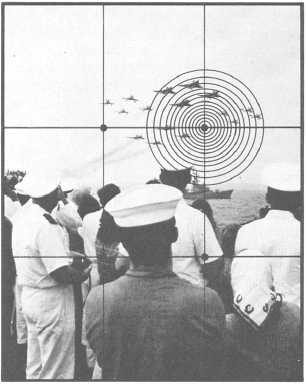nothing in the photograph to attract attention to a
particular area, the eyes wander throughout the scene.
The point of interest maybe a single objector numerous
ones arranged so that attention is directed to one definite
point.
Lines, shapes, human figures, and so forth, should
be directed so that they look or move toward the point of
interest in the picture. If you have a group of people
gathered around a table, keep the interest intact and
centralized by having them look at each other or at one
individual of the group. A perfect example of this is The
Last Supper by Leonardo da Vinci. This unity of interest
causes the observer’s eyes to be drawn to the same point.
Human figures attract attention more strongly than most
other subject matter.
For instance, a photograph showing a person
standing at a distance in front of a building may leave
the observer wondering whether the person or the
building is the main subject. When you include people in
a scene, do not photograph them looking directly at the
camera. When people look directly at us, we normally
return the gaze by looking directly into their eyes.
However, when they look in another direction, our
attention is drawn from them to the point at which they
are looking. Thus if people are grouped around a piece
of machinery or an aircraft (the main object of the
photograph), have them look at the object, rather than at
the camera.
Rule of Thirds
Point of interest, as used in this section, is
Frequently called the center of interest. It is called
“point” at this time simply to prevent giving the
impression that it would be located in the center of the
photograph space.
Although good composition can at times be
obtained by placing the point of interest in the
geometrical center of the photograph area it is a good
idea to avoid placing it there. The frequently it divides
the photograph into equal halves and makes it difficult to
create a feeling of balance. Some photographers draw
lines on the ground glass, dividing the photograph into
thirds both vertically and horizontally, and thereby
locate the point of interest at one of the four intersections
of these lines. This division is sometimes referred to as
the rule of thirds (fig. 12-9) — a concept briefly covered
in Chapter 8. You will find that one of these
intersections is the best location for the point of interest
and gives the best feeling of balance to the composition
of the photograph. Most of the attention should be
attracted to and held at this point. An artistic feeling for
Figure 12-9.—The rule of thirds
arrangement is an invaluable aid in composing a scene in
order to make a striking photograph.
If the principal object is too close to one edge,
appears top-heavy or if it in any way leaves the observer
feeling that it is misplaced in the photograph, the point
of interest should be moved to another location. You
also may change the camera angle to include another
object and balance the composition.
Leading Lines
One of the most common techniques in directing
attention toward the point of interest is the use of leading
lines, shapes or patterns. You can use leading lines to
convey psychological impressions; curved lines lend
grace to a photograph and strong horizontal lines
combined with vertical lines indicate strength and
power. The leading line may be a road, an armor leg, a
shoreline, a patch of light or dark tones in the scene, or a
line of sight (fig. 12-10). A good leading line is one that
starts near a corner of the scene and continues unbroken
until it reaches the point of interest. It should end at this
point; otherwise, attention is carried beyond the main
object in the photograph.
12-12


